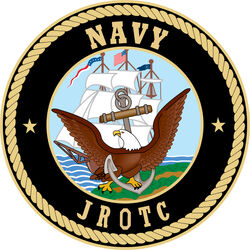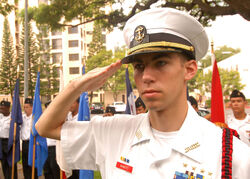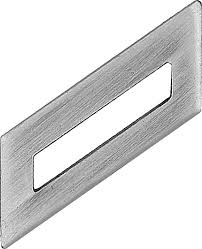The Navy Junior Reserve Officers Training Corps (NJROTC) program was established by Public Law in 1964 and may be found in Title 10, U.S. Code, Chapter 102. The program is conducted at accredited secondary schools throughout the nation, by instructors who are retired Navy, Marine Corps, and Coast Guard officers and enlisted personnel. The NJROTC curriculum emphasizes citizenship and leadership development, as well as our maritime heritage, the significance of sea power, and naval topics such as the fundamentals of naval operations, seamanship, navigation and meteorology.

Navy JROTC emblem.
Program[]
Classroom instruction is augmented throughout the year by community service activities, drill competition, field meets, flights, visits to naval activities, marksmanship training, and other military training. Uniforms, textbooks, training aids, travel allowance, and a substantial portion of instructors' salaries are provided by the Navy.
The naval science program is constructed to include three academic classroom sessions and two activity periods per week. The curriculum is based on 40-minute sessions of instruction for 36 weeks, with 180 teaching days. This equates to 7200 minutes of contact instruction (72 hours of classroom instruction and 48 hours of activities including military drill and athletics).
Adjustments for class length other than 40-minute periods, as well as staggered, rotating or modular schedules, are made at the local school level. Some subjects included in the curriculum are:
- Naval Orientation
- Naval Operations/Organization
- Naval History
- Navigation
- Seamanship
- Leadership
- Nautical Astronomy
- Electronics
- Oceanography
- Drills, Commands, and Ceremonies.
[]
Introduces students to the meaning of citizenship, the elements of leadership, and the value of scholarship in attaining life goals; engender a sound appreciation for the heritage and traditions of America, with recognition that the historically significant role of sea power will be important in America's future; develop in each cadet a growing sense of pride in his/her organization, associates, and self. These elements are pursued at the fundamental level.

Navy JROTC Cadet Adam Burkett of Radford High School, salutes the colors at a Memorial Day ceremony at the Pearl Harbor Submarine Park and Parche Memorial. U.S. Navy Photo By Mass Communication Specialist 3rd Class John W. Ciccarelli. (RELEASED)
The course includes introduction to the NJROTC program; Introduction to Leadership, Naval Ships; Mission and Organization, The Nation, Navy and the People in American Democracy, Maritime Geography, Seapower and Challenge, Naval History through 1815, Introduction to Navigation and Time, Basic Seamanship, Oceanography, Health Education, First Aid, and Drugs, Alcohol and Tobacco Abuse Prevention.
The course provides ongoing instruction in leadership theory, Naval Orientation and Career Planning, Citizenship in the U.S. and Other Countries, Naval History: 1815 through 1930, Naval Ships and Shipboard Evolutions, Naval Weapons: Gunnery, Guided Missiles and Mines, Navigation Fundamentals and Rules of the Road, Small Boat Seamanship, Meteorology and Weather, and Survival Training and Orienteering.[1]
[]
Broadens the understanding of students in the operative principles of military leadership, the concept and significance of teamwork, the intrinsic value of good order and discipline in the accomplishment of objectives, the fundamentals of American democracy, and to expand their understanding of naval academic subjects.
The course provides ongoing instruction in leadership and discipline, Military Justice, Astronomy, International Law and the Sea, National Strategy, Sea Power and Naval Operations, Naval History: 1930 through the Nuclear Age, Naval Intelligence and National Security, Maneuvering Board, Challenges of Future Navy Research, and Electricity and Naval Electronics.
[]
Focuses solely on practical leadership. The intent is to assist the senior in understanding leadership and improving their leadership skills by putting them in positions of leadership, under supervision, then helping them analyze the reasons for their varying degrees of success through the year. Classroom activities include seminars, reading assignments, classroom presentations, and practical work with younger cadets.
The course curriculum includes instruction in theoretical and applied aspects of leadership, training, and evaluation of performance. Students will become aware of the techniques used to create motivation, develop goals and activities for a work group, and the proper ways to set a leadership example. Cadets will also apply these principles when dealing with younger cadets in the areas of military drill and inspections, athletic events, and in other school activities.
Uniforms[]
There are currently several uniforms the can be worn by cadets, Naval service uniform, Khaki's, Dress blues. The Naval sevice uniform is the uniform worn by active duty sailors, while Khaki's are worn by Senior enlisted and officers only.
Cadet Enlisted Ranks[]
NJROTC Enlisted (E) ranks are the same for E's 1-6, but are different for E-7, E-8, E-9.
Cadet Master Chief is usually only given to on cadet, or a alternate senior rank is made. This rank is for the Command Master Chief of a Unit. This alternate Rank is similar to that of the Master chief petty officer of the Navy.
Cadet Officer Ranks[]
Officer ranks are for usually 3rd or 4th year cadets or for cadet in leadership positions.
| Rank/Abbreviation | Picture | Rate |
|---|---|---|
|
Cadet Ensign C/ENS |
0-1 | |
|
Cadet Lieutenant Junior Grade C/LTJG |
0-2 | |
|
Cadet Lieutenant C/LT |
0-3 | |
|
Cadet lieutenant Commander C/LTCDR |
0-4 | |
|
Cadet Commander C/CDR |
0-5 | |
|
Cadet Captain* C/CAPT |
0-6 |
Cadet Captain can only be obtained by a school with the need for a larger officer pool.
Instructors[]
The Head of the Department of Naval Science at a school hosting an NJROTC program is called the Senior Naval Science Instructor (SNSI). The SNSI is the senior commissioned officer employed by the school. All other personnel employed by the school in the NJROTC Program are called Naval Science Instructors (NSI). At the school's option, one of the instructors may be a retired member of the Marine Corps or Coast Guard who is certified by the Navy to serve in the NJROTC program.
Senior Naval Science Instructors (SNSIs) are commissioned officers (W2 through O6). Naval Science Instructors (NSIs) are retired enlisted personnel (E-6 through E-9). The minimum education requirement for SNSIs is a baccalaureate degree from an accredited college or university. A high school diploma or its equivalent is required of NSIs. Specific instructor qualification requirements will remain the decision of school officials who are the employers of these individuals. The Chief of Naval Education and Training enforces stringent certification requirements on all personnel applying to the NJROTC program. School officials may not offerm. employment to an applicant who does not possess a valid CNET certification.[1]
| ||||||||||||||||||||
- ↑ 1.0 1.1 Navy JROTC GLobal Security Org, Retrieved: 2008-09-08


